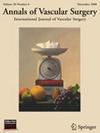牛颈动脉移植物与聚四氟乙烯移植物用于血液透析:系统回顾和荟萃分析。
IF 1.6
4区 医学
Q3 PERIPHERAL VASCULAR DISEASE
引用次数: 0
摘要
在没有合适的静脉形成动静脉瘘的患者中,考虑采用动静脉移植物进行血液透析。最常用的合成聚四氟乙烯(PTFE)移植物具有较高的感染风险(6%至29%)和有限的生物相容性。牛颈动脉移植物(BCAG),一种生物替代品,可以解决这些局限性。本系统综述和荟萃分析比较了BCAG与PTFE移植物的临床结果。方法:检索MEDLINE、Embase和Cochrane图书馆中符合条件的研究(PROSPERO, no. 5;607603)。纳入纳入BCAG通路患者的研究,排除2000年之前发表的研究。如果报告了ptfe结果,则将其汇总进行比较。主要结局是(移植物)感染。次要结局包括原发性、原发性辅助和继发性通畅以及术后并发症。meta分析和亚组分析采用随机效应模型。结果:11项研究(1项随机对照试验和10项队列研究)共1247例患者符合纳入标准。BCAG和PTFE的感染率相似(64 vs 95 / 1000患者年;p=0.43)。12个月时,BCAG显示原发性(47%对29%,p=0.02)和原发性辅助通畅(66%对34%,p=0.004)显著增加。BCAG组12个月时的二次通畅率没有显著提高(78% vs. 57%; p=0.10)。两组术后并发症发生率无差异。结论:与聚四氟乙烯(PTFE)移植物相比,BCAG在血液透析通路中具有优越的初级和初级辅助通畅性。其他结果也有利于BCAG,但缺乏统计学意义。有必要进行大规模随机试验,以进一步确定BCAG的作用,并支持基于证据的决策。本文章由计算机程序翻译,如有差异,请以英文原文为准。
Bovine Carotid Artery Grafts versus PTFE Grafts for Hemodialysis Access: A Systematic Review and Meta-Analysis
Background
Arteriovenous grafts are considered for hemodialysis access in patients without a suitable vein for the creation of an arteriovenous fistula (AVF). The most commonly used synthetic polytetrafluorethylene (PTFE) graft carries a high risk of infection (6–29%) and limited biocompatibility. The bovine carotid artery graft (BCAG), a biological alternative, may address these limitations. This systemic review and meta-analysis compared the clinical outcomes of BCAG versus PTFE grafts.
Methods
MEDLINE, Embase, and Cochrane Library were searched for eligible studies (PROSPERO, no. 607603). Studies including patients with BCAG access were included, and those studies published before 2000 were excluded. If PTFE outcomes were reported, they were pooled for comparison. The primary outcome was (graft) infection. Secondary outcomes included primary, primary assisted and secondary patency, and postoperative complications. Meta-analyses and subgroup analyses used random-effects models.
Results
Eleven studies (one randomized controlled trial (RCT) and 10 cohort studies) involving 1,247 patients met the inclusion criteria. Infection rates were similar between BCAG and PTFE (64 vs. 95 per 1,000 patient years; P = 0.43). At 12 months, BCAG showed significantly higher primary (47% vs. 29%; P = 0.02) and primary assisted patency (66% vs. 34%; P = 0.004). Secondary patency at 12 months was not significantly higher in the BCAG group (78% vs. 57%; P = 0.10). No differences were observed in the incidence of postoperative complications.
Conclusion
BCAG demonstrated superior primary and primary assisted patency compared to PTFE grafts in hemodialysis access. Other outcomes also favored BCAG but lacked statistical significance. Large-scale RCTs are warranted to further define the role of BCAG and support evidence-based decisions.
求助全文
通过发布文献求助,成功后即可免费获取论文全文。
去求助
来源期刊
CiteScore
3.00
自引率
13.30%
发文量
603
审稿时长
50 days
期刊介绍:
Annals of Vascular Surgery, published eight times a year, invites original manuscripts reporting clinical and experimental work in vascular surgery for peer review. Articles may be submitted for the following sections of the journal:
Clinical Research (reports of clinical series, new drug or medical device trials)
Basic Science Research (new investigations, experimental work)
Case Reports (reports on a limited series of patients)
General Reviews (scholarly review of the existing literature on a relevant topic)
Developments in Endovascular and Endoscopic Surgery
Selected Techniques (technical maneuvers)
Historical Notes (interesting vignettes from the early days of vascular surgery)
Editorials/Correspondence

 求助内容:
求助内容: 应助结果提醒方式:
应助结果提醒方式:


